
As much as we love quick and straightforward solutions, in Linked Helper we often have to invent multi-step workarounds for certain customers’ tasks. “How to send automatic messages to women only on LinkedIn?” is a pretty common request.
There’s no surefire way to quickly determine the gender on LinkedIn, aside from viewing each profile. For those who have better ways to spend time, there is LinkedIn automation. But even with tools like Linked Helper, sorting a big list of profiles into ‘F’ and ‘M’ boxes is not a one-step operation. We do have our well-proven workarounds for this.
Yet, with the release of the famous Chat GPT, we were curious to see what AI has to offer. When presented with this task, much to our surprise, it stated that some roles are predominantly held by men and we can use it as a sorting criterion. That’s not the exact solution we had expected, but it touched off our curiosity. Is that really so? Who could give us a better answer than the #1 social platform for professionals? We turned to LinkedIn to find out how men and women are represented across various roles.
Key notes:
- LinkedIn doesn’t have a gender filter or a gender attribute for people’s profiles. Hence, most automation tools are unable to quickly scrape and determine the person’s gender.
- A combination of data scraping tools like Linked Helper + a name-checker app returns gender data for huge lists with a 99 probability score%.
- In the United States, 78% of CEOs are male, and 22 % are female, judging by LinkedIn profiles. Norway shows even more male-centric results – 87% vs 13% female.
How to determine the recipient’s gender on LinkedIn
So you are faced with a tricky task to message only women on LinkedIn. Viewing each and every profile yourself to determine the gender is out of the question, as you want to reach big audiences. Besides, who does that manually in 2023? How do you pick female profiles from thousands of others on LinkedIn?
LinkedIn profiles don’t have the gender field to fill out when you create your page. Clearly, that makes it impossible for any LinkedIn data scraping tools or LinkedIn automation tools to simply obtain gender data. Most data scraping tools just collect LinkedIn profile data; they don’t build on it nor do they derive any conclusions. If some data is not there, it can’t be collected either.
There’s the preferred pronouns field, on the other hand, where you can indicate that you are a man (he/him) or a woman (she/her) or gender-neutral (they/them), or a custom pronoun. But few people choose to fill it out. Plus, pronouns may be visible to 1-st degree connections only, so it is of limited help either.
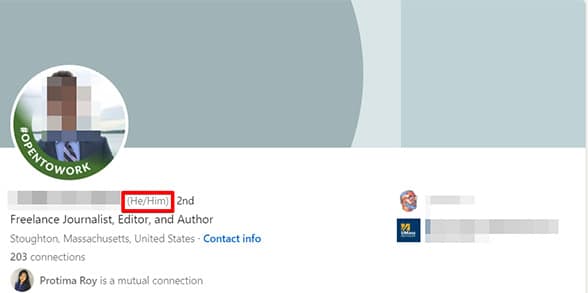
Another option could be searching for female or male communities on LinkedIn.
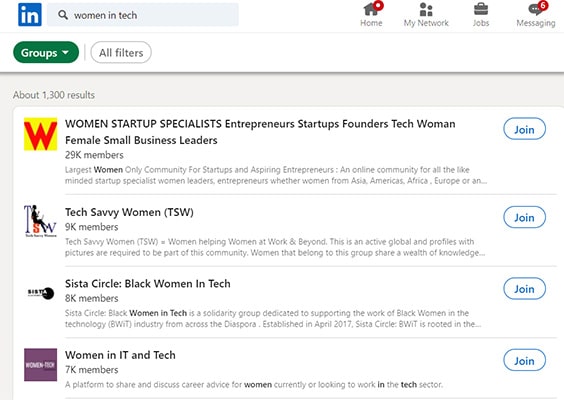
Joining LinkedIn groups to have access and reach out to its members is a worthy strategy and we’ve covered it in the “How to reach group members” guide and a video tutorial. But surprisingly, women groups on LinkedIn may have male members, too. So, technically, you cannot fully rely on the group title.
Chat GPT
At some point, we were curious to see what Chat GPT has to offer. We explicitly asked it how to send automatic messages to women or men only in Linked Helper. Much to our surprise, it suggested that profile gender could be determined by job title.
You can use the ‘Title’ filter to search for male recipients by targeting specific job titles predominantly held by men, it said. Titles included, according to Chat GPT, CEO, COO, Manager, VP, and engineer roles.
Any moral argument aside, we decided to put that to test ourselves. Are women and men equally represented in certain industries or job titles, as it appears on Linkedin?
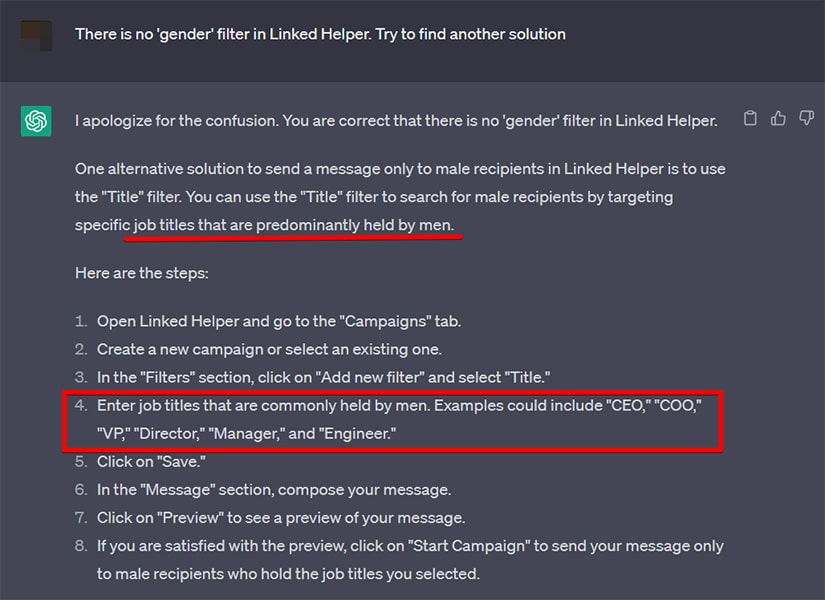
The Experiment
The experiment breaks down into 4 stages.
First, we need to target a specific job title. Let’s take CEO, for example. Precise your search query with booleans – Ceo NOT Founder. To narrow down the target group, select a specific location. We decided to look country-wide at the United States. We will also be looking at Norway, just to balance off our conclusions and to see how results may vary depending on geography.
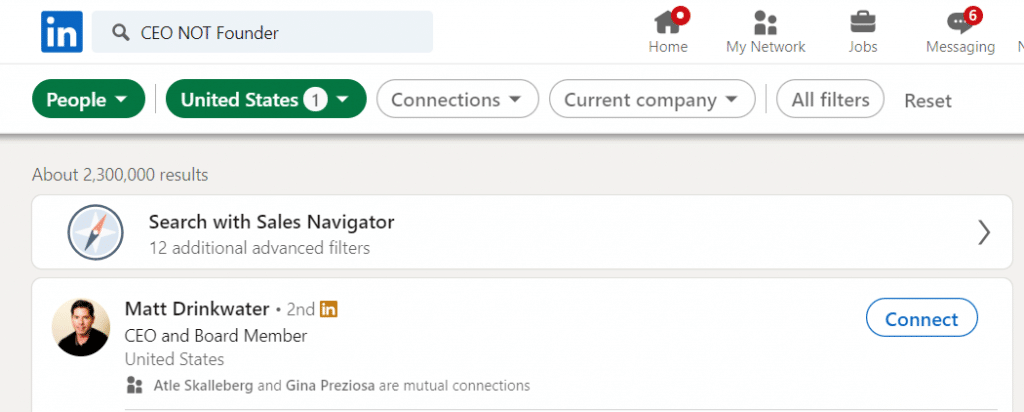
Next, collect profiles into a list using the Linked Helper collecting tool. This will take between 5 to 15 minutes to pull 1000 profiles from the search. If you need more profiles, consider our tactics to build a bigger list.
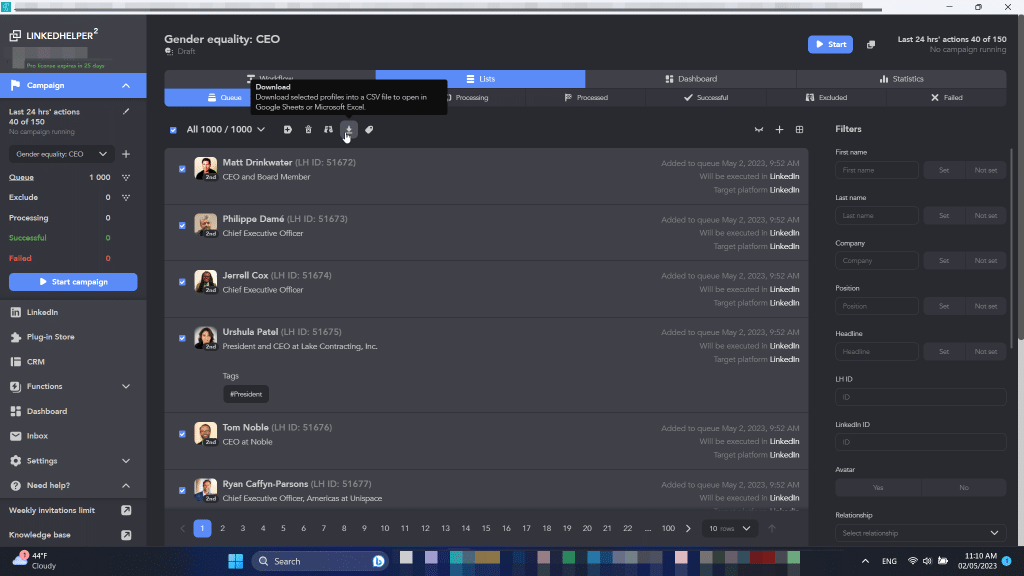
Third, we’ll export this list into a CSV file and open it in MS Excel. Since we don’t have a gender attribute, we will rely on names to determine the gender.

Fourth, using third-party services or name catalogs, of which there are plenty out there, we’ll define female vs. male recipients.
From 1000 USA-based CEO profiles we had 780 male and 220 female names.
If I further wanted to message women only, I’d then use Linked Helper. I would copy men’s profile URLs and upload them into the Exclude (not-to-process) list of my campaign, while women’s profile URLs would be uploaded to the Queue (to-process list).
Results: the United States and Norway share an 80/20 pattern
In the United States, С-level positions are indeed dominated by men, amounting to 80% of profiles on average. A slightly different proportion can be seen for the ‘Manager’ role, where women took up 61% of the list – largely because ‘manager’ encompasses a broad spectrum of roles: project manager, HR manager, store manager, and customer success manager – all quite accessible to women. In Norway, things look pretty similar in terms of male vs female presence in managerial roles, as seen from the data below.

Quality of your data
In this approach we heavily rely on:
(1) the accuracy of LinkedIn search results;
(2) the accuracy of the name-checker app.
So how reliable is the data? LinkedIn may occasionally return irrelevant profiles in the search results, especially on a free LinkedIn account. For example: if you search for CEOs, you will see quite a number of profiles that read “Executive Assistant to CEO” as well.
At this stage, applying boolean search operators (Graphic NOT Web designer) or using ‘Title’ keyword for search may increase the search relevance.
Then, Linked Helper offers you a powerful in-built filtering tool to further refine your search results. With the ‘Position’ and ‘Headline’ filters we’ve found that nearly one-third (287 of 1000) of CEOs are also appointed Presidents in their company 🙂
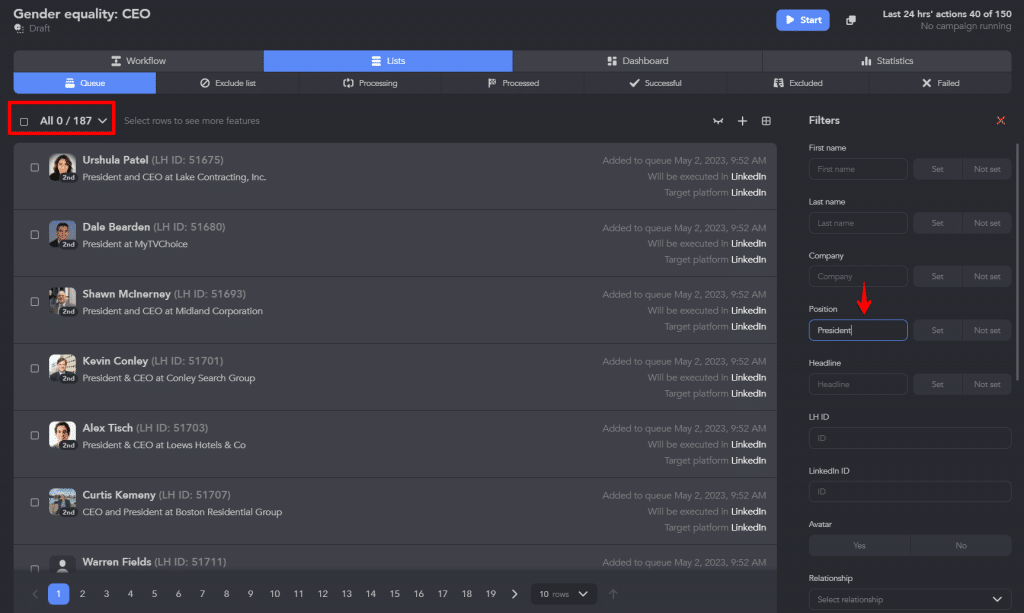
As for the name checker, Namsor gave us the % probability score next to each name, so we could assess if it was a reliable guess.
Luckily, more than half (671) of the profiles had been given a 100% probability score. 200 more profiles were between 95-99% on a probability scale. We also had 20 names with a 50% probability score – the lowest estimate. But we quickly checked them individually using the Linked Helper filtering tool.
As Linked Helper also shows profile avatars, a swift glance is often all it takes to confirm the gender.
We had doubts, but Jackie is female 🙂:

If there was any ambiguity about the gender, we removed this profile from our campaign (better safe than sorry):

Conclusion
Of course, our research is not by any means an in-depth look at the real situation with gender equality on the market. However, we must admit that Chat GPT wasn’t far from the truth when saying that, at least on LinkedIn, at least for the specific task where we need to sort profiles into male or female lots, relying on job titles could be a not-so-bad approach. Many managerial positions remain male positions, for the most part. And that is backed up by the latest research, such as the McKinsey Global Institute or the World Bank Data.
That said, gender equality does not imply simply an equal number of men and women holding certain positions. Equal pay, access to education, and promotion opportunities are by far more important indicators.